Movie Review By: SFAM
Year: 1995
Directed by: Stephen Norrington
Written by: Stephen Norrington
IMDB Reference
Degree of Cyberpunk Visuals: Medium
Correlation to Cyberpunk Themes: Low
Key Cast Members:
Jack Dante: Brad Dourif
Hayden Cale: Ely Pouget
Sam Raimi: John Sharian
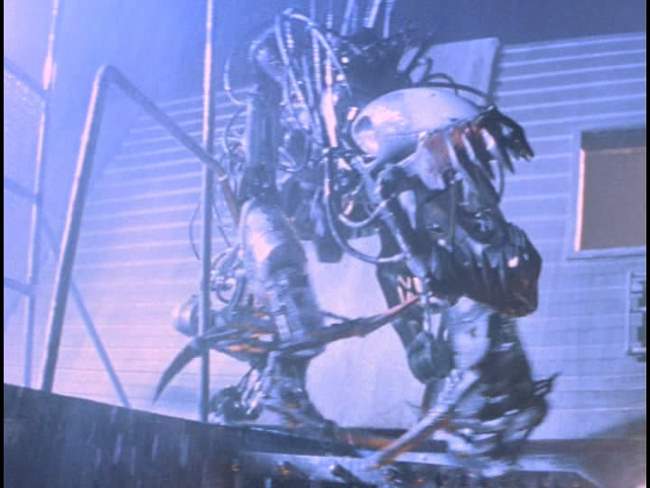
Overview: In yet another of the Alien/Terminator copycat movies, Death Machine is a low-budget, poorly thought out shlock-fest that tries to dazzle you with a largely incoherent in-depth plot and over-the-top acting. While another virtually unknown British Director, Richard Stanley, scored big in a similar but far more original copy-cat movie, Hardware, Stephen Norrington’s Death Match just doesn’t cut it. These types of movies live or die on the overall atmosphere and the quality of the fear the creature engenders. While Hardware excelled on both counts, Death Machine falls woefully short. Worse, Death Machine makes a lame attempt at humour by naming all the bit players with the names from the movies Norrington stole plot bits and visuals from (John Carpenter, Scott Ridley, Weyland, and Yutani)
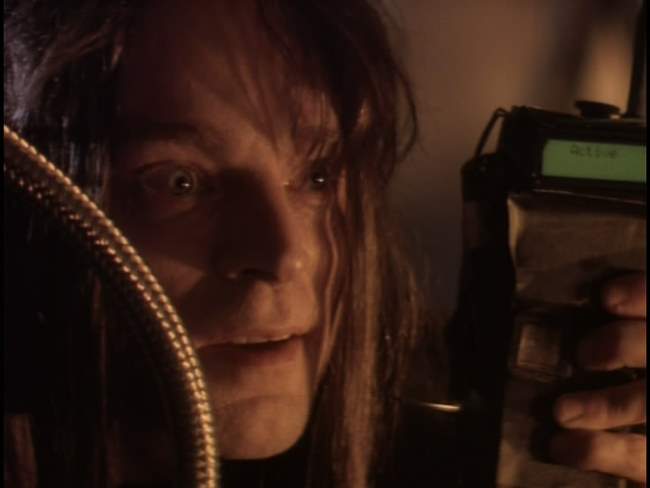
The Story: In the near-future, the evil Chaank Armaments corporation has engaged in a number of shady, classified project that have resulted in dissapearances and potential deaths. Public outcry has gotten out of hand, so for damage control, they bring in an upstanding principled new chief executive named Hayden Cole (Ely Pouget), a hot chick with a porn past to inspire trust and confidence amongst the masses. As she delves into things, it’s clear that the board of directors wants nothing to do with providing full disclosure. Why? Because there is an evil genius mad scientist in the basement named Jack (Brad Dourif), who has the dirt on everyone, and is hard at work at making a death machine to keep everyone in line. Additionally, Jack has created a process for transforming humans into killer-cyborgs. Unfortunately, this process is flawed, and all the cyborgs end up dying.
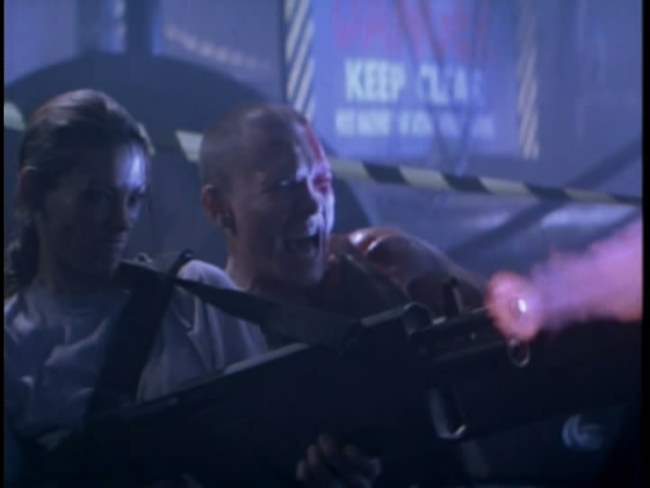
Eventually, the hawt chief executive challenges Jack, and all hell breaks loose. She and a few others become trapped in the building with some would-be amateur freedom fighter cyberpunk types who have invaded the corporation in the hopes of destroying it. Now they are all just trying to escape the robot known as the War Beast. Hayden and Sam Raimi (John Sharian), the leader of the amateur terrorists, spend the rest of the movie trying to evade and eventually kill the War Beast. I could go into more of the plot, but truly, its just not worth it.
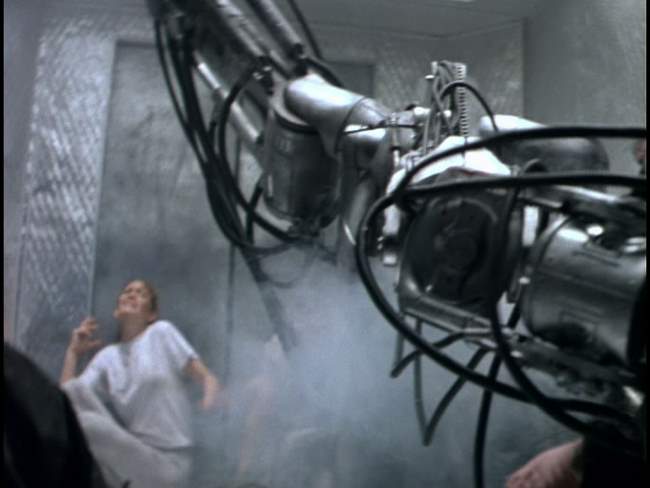
The Robot Monster: OK, so we have this really tough robot thing – virtually indestructible. Anyone wanna tell me why this robot has like a hundred rubber tubs hanging out, and nobody who fights it in hand-to-hand combat thinks of grabbing them? More to the point, why don’t the thousands of rounds of bullets affect the tubes? Bottom line, this robot was more silly than scary. In Hardware, the robot was continually shown moving quickly in low-light situations. This allowed Stanley to get away with a low-tech, but very believable robot. Unfortunately, Death Machine doesn’t take this approach – it shows the robot in detail to make sure you see its faults. Color me not impressed.
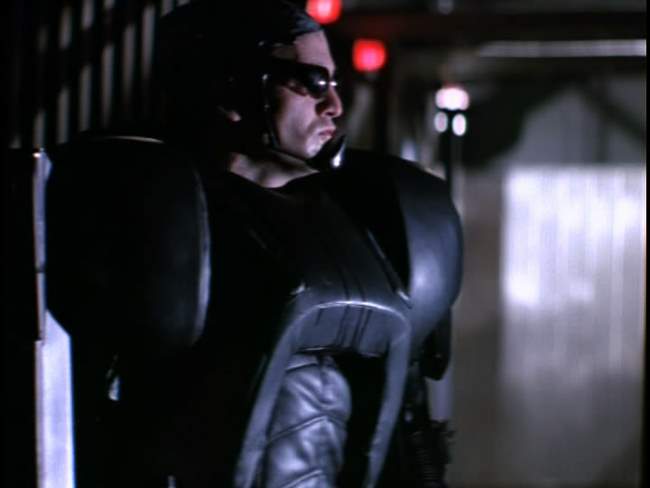
Yes, ladies and gentlemen, you can tell this is a cyborg because he’s wearing sunglasses. Also, he has that really big vinyl and plastic whatever-the-fuck-it-is on - DEFINITELY a sure sign of a cyborg warrior!
Death Machine’s Approach to Cyborgs: In Death Machine, the Chaank Armaments Corporation creates cyborgs by wiping someone’s memory and uploading it with detailed weapon systems training, and simple goals (e.g., protect me, seek out and kill “guy X”). In short, its approach to cyborgs assumes the human mind is synonymous with a hard disk. They even have an instance where a key character’s personality “backed-up” and then wiped from his mind to allow the “warrior personality” to be installed, and then later, they reload the initial personality. Puleeze, Norrington! I’m sure you coulda come up with a marginally believable cyborg warrior rationale. Too bad you didn’t take the time to think of one.
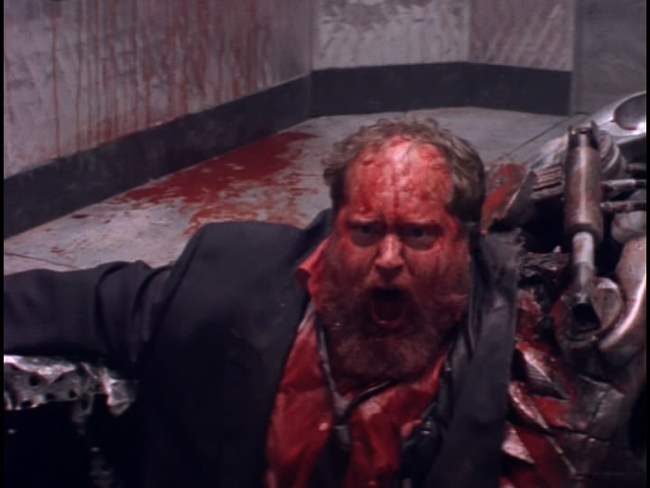
The Bottom Line: Truly, to even have a chance of being watchable, Death Machine would have needed to incorporate a heavy dose of T&A. While Ely Pouget has the looks, this never materializes. This is all the more annoying in that the inclusion of the porn reference flat out portends juicy T&A. Instead, we’re left with a shlock “B” movie, absent of T&A, without the effects, acting, plot or monster to carry the day. Brad Dourif’s character, while mildly amusing is just too over-the-top to stomach, and nobody else other than Pouget even stands out. Even worse, they screw up what should have been a very simple ending (this may be the only original part of the movie - in retrospect, Norrington should have copied this as well), leaving us with a almost complete let down, and no payoff for sticking around for 2 hours. In short, I don’t see much to recommend here.
~See movies similar to this one~
Movie Review By: SFAM
Year: 1993
Directed by: Fred Dekker
Written by: Frank Miller & Fred Dekker
IMDB Reference
Degree of Cyberpunk Visuals: Medium
Correlation to Cyberpunk Themes: Low
Key Cast Members:
RoboCop: Robert John Burke
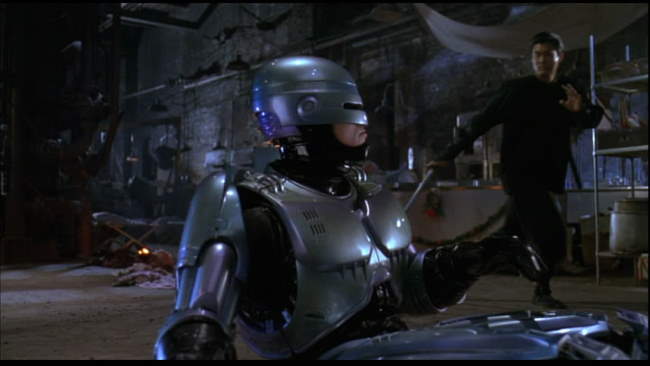
Overview: The first Robocop movie was an absolutely terrific, innovative flick. Robocop 2 really sucked, but not as bad as Robocop 3. All pretense of putting together a decent movie goes away in Robocop 3. Peter Weller, who plays Robocop in the first two movies wisely skipped this piece of shit. The only remaining cast members from the first are the Police Captain, Officer Lewis (Nancy Allen), the stooge corporate dude, Johnson (Felton Perry). Of these, only Officer Lewis had any chance of carrying a decent amount of heft for the show, but she is prematurely bumped off without reason, and the other two are pretty much just caricatures of themselves. In short, Robocop 3 is a pure, low-budget trashy sellout made for 8-14 year-olds who were familiar with the G-rated series - the plot goes for the young genius hacker kid and ninja bad guy vice attempting to work up a real plot.
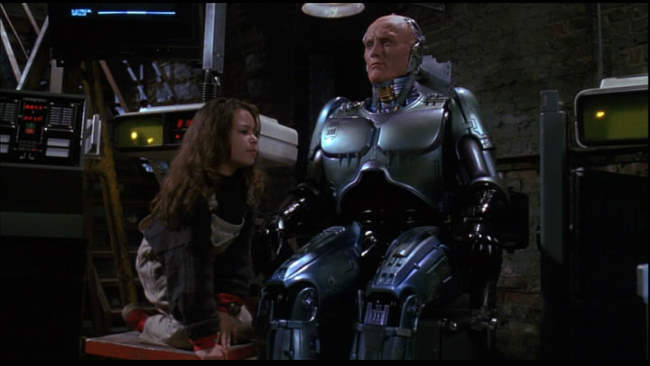
The Story: Like Robocop 2, OCP is still trying to create a massively expensive city in a place that only has the destitute poor. God knows why, as nobody will be able to afford ANYTHING created, but we’re just supposed to go with it. In this episode, we have the nasty Japanese buying up OCP and hiring a cheesy security firm to simply gather up all the poor people and ship them out to concentration camps. But Robocop doesn’t like this, and decides he no longer feels like obeying his prime directive that stops him from challenging OCP employees. Instead, he joins a ragtag resistance comprised of local yokels, the genius kid, and of course his sympathetic OCP scientist care taker. But wait! There’s more! The evil Japanese have sent a cyborg ninja to kill Robocop. Ohhhhhhh – you can just cut the tension with a plastic spoon!
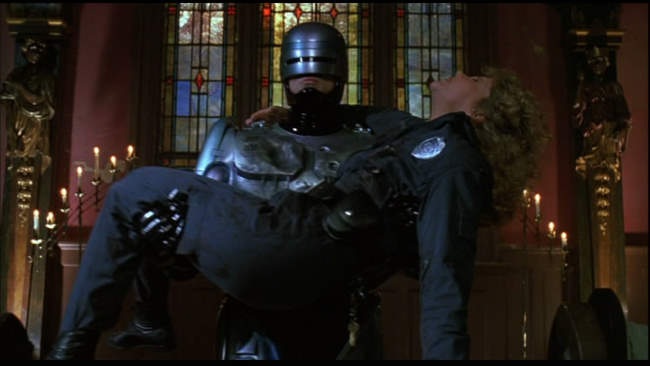
The Bottom Line: Honestly, I have a hard time seeing how Frank Miller is in any way responsible for the screenplay for this piece of trash. It’s pretty sad to see the Robocop movies end in such a trashy way. Yes, there is another kiddie miniseries that follows this, but truly, Robocop should have stopped after the first. This franchise is the poster child for Hollywood fuckups. In thinking about it, they could have done quite a lot with the Robocop universe, and potentially even could have done interesting things with the original Robocop character. Instead, they choose the cheesy derivative path. This led to both less money and the painful death of the cash cow.
~See movies similar to this one~
Movie Review By: SFAM
Year: 1996
Directed by: Jon Kroll
Written by: Mark Valenti
IMDB Reference
Degree of Cyberpunk Visuals: Low
Correlation to Cyberpunk Themes: Medium
Key Cast Members:
Menno: Bill Campbell
Loria: Stephanie Romanov
Mick Dourif, Rebel Leader: Bruce Campbell
Simon, Menno’s Friend: Michael Dorn
Felix Medina: Corbin Bernsen
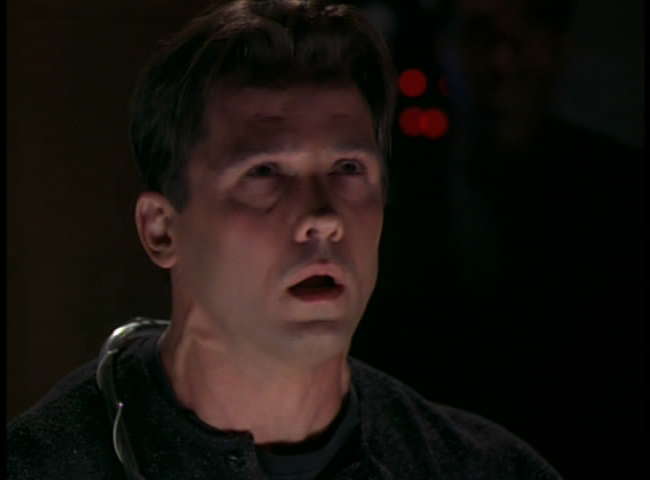
Overview: Here we have a movie with Bruce Campbell, Michael Dorn, and the very hawt Stephanie Romonov – this movie’s got to have something appealing, right? Um, not really. Menno’s Mind, a Showtime production is nowhere close to ready for prime time. The only thing worse than the acting and effects is the completely incoherent story. The FX are crappy low budget ones, but truly, nothing else in the movie even comes close to equaling them.
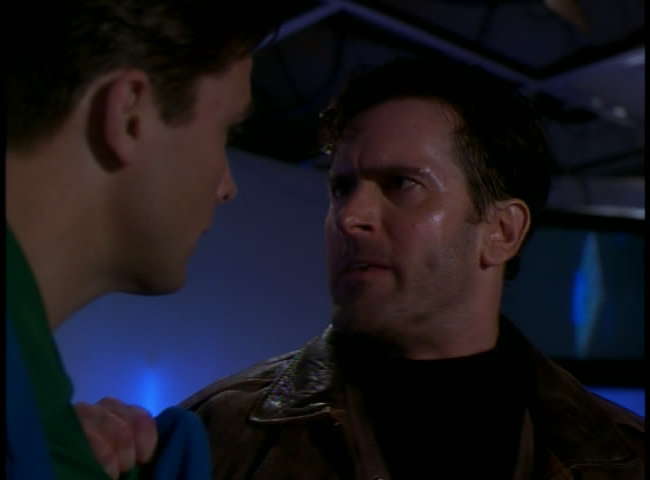
The Story: Menno’s mind takes place in a bizarre, cheesy future where everyone dresses in tacky bright clothes, except for the tough chicks, who wear black leather. Menno (The Rocketeer’s Bill Campbell) is a sappy computer programmer at a very popular virtual reality resort that provides people a choice of interesting vacations (most choose the virtual sex chick on the beach). The “System” that runs the VR vacations is very powerful, and has the capability to implant thoughts and suggestions into the vacationers. The resort’s head of security, Felix Medina (Corbin Bernsen), also happens to be running for President of the US (I shit you not…how far that office must have fallen for a head of security of a resort to be in the running!), and has decided to game the election by getting everyone who takes a vacation to be implanted with thoughts to vote for him in the election.
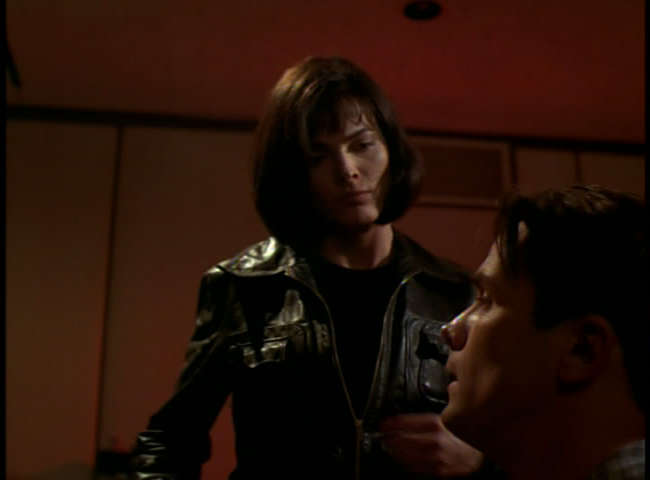
Luckily, disgruntled employee and rebel leader, Mick Dourif (Bruce Campbell), figures out the dastardly ploy and tries to stop it. Unfortunately, the bad guys have found him, and ambush his hideout. He barely escapes, goes to the VR resort, and forces Menno to upload his mind into the VR system before he dies! Yep, you heard it right, ladies and gents – although it wasn’t in the specs, apparently the VR system has the ability upload a human mind. Then things get interesting when Mick’s girlfriend, Loria, finds Menno and forces him to download Mick’s mind into himself in order to find out what Mick knew about the dastardly plot! From there, the race is on.
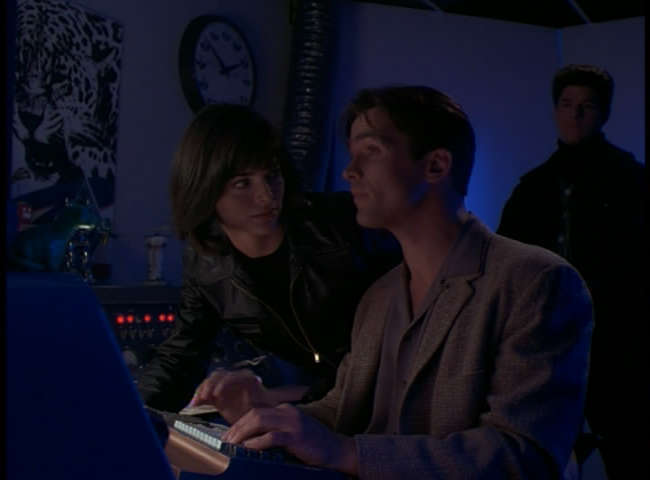
The Bottom Line: Truly, the number of problems and plot holes in this are almost uncountable. I’ll give it three stars because the production values are at least decent, but the story sucks more than words can describe. OK, so a security manager is running for President of the US – perhaps he should consider campaigning instead of trying to game a few hundred votes by convincing those who show up in the morning to vote for him – just a thought! I could go on, but the fairy science shown in this doesn’t even try to hold itself together. Worse, Bruce Campbell – really, the only reason I wanted to see this (I LOVE Army of Darkness!!!), dies early enough on that you barely get a chance to enjoy him.
~See movies similar to this one~
Movie Review By: SFAM
Year: 1999
Directed by: Scooter McCrae
Written by: Scooter McCrae
IMDB Reference
Degree of Cyberpunk Visuals: Low
Correlation to Cyberpunk Themes: Medium
Key Cast Members:
Ginny Chin-Chin: Jane Chase
Adrian Torque: Crawford James
Alik Silens: Alice Liu

Overview: WTF!!! That pretty much sums up Sixteen Tongues. This low-budget softcore cyberpunk porn flick has potential in some of its thoughts, but just loses out in editing, movie making basics like clear dialogue and pointless filler scenes. Low budget flicks often free the director to stop paying attention to movie conventions and potentially create something unique. But to make this pay off, some of the basics of crafting still need to be worked.
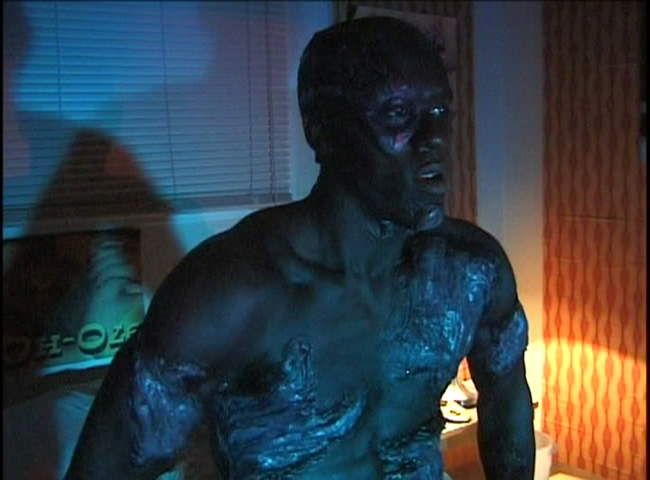
The Story: In a dystopic, seedy future, where humanity is fleeting, Sitxteen Tongues follows the plight of three emotionally scarred people (one physically scarred as well). Adrian (Crawford James) is a severely scarred police officer who seemingly died in a previous conflict, but was brought back to life, and had his damaged skin repaired by replacing it with sixteen tongues. His tongue skin, which forces him to taste his own clothes and everything he touches, has since made him go crazy – he hears voices and every now and then, and randomly goes on murderous rampages. Ginny Chin-Chin is a bio-modified assassin droid who has had sexual implants causing her to organism every time she blinks her eyes. The implants help her resist the urges to kill, but she still is driven to find her maker and rip him into shreds. Alik is a hacker extraordinaire, and is Ginny’s lover. She spends her time trying to find Ginny’s maker, but also has the ability to user her equipment to ghost-hack into other’s minds.
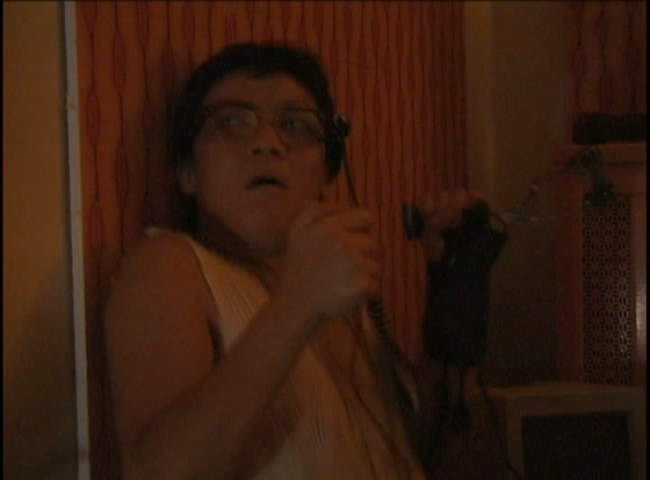
All three characters are emotionally traumatized. Alik and Ginny spend half the movie fighting about whether they really care for one another. Adrian is caught up in his own paranoid delusions. Through a chance encounter to get ice, Ginny and Adrian meet up. Ginny goes to his room (which has porno films playing non-stop) and finds out he’s a cop. She thinks he can help her in finding her maker, so she gives him oral favors in exchange for potentially helping her. While Ginny is having sex with Adrian, Alik hacks into Adrian’s TV signal and watches them. More arguments ensue.
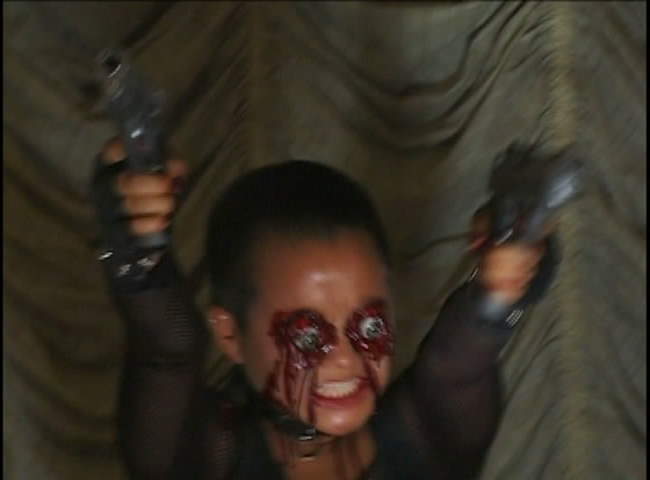
Eventually things come to a head due to Adrian’s paranoid delusions. In scanning Ginny’s bar-code, he knows she is a dangerous murderer, and for some reason, begins to think Ginny is actually responsible for his murderous rampages. Confrontations occur, and things spiral out of control from there.
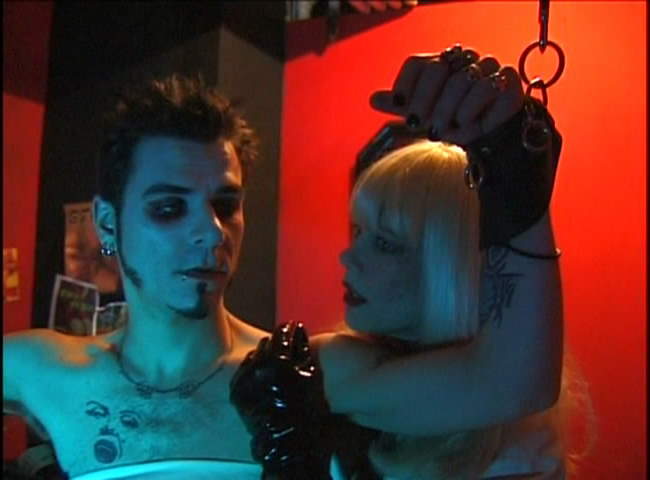
The Set: The entire movie takes place in a few rooms in a seedy hotel with porn posters covering all the walls. The hotels don’t look at all futuristic, aside for the credit card swap machines everywhere. They do at least look very seedy and lived in, although the random people sleeping on the floor was probably overkill. Also, we eventually learn that complete sexual deviants fill virtually every hotel room.
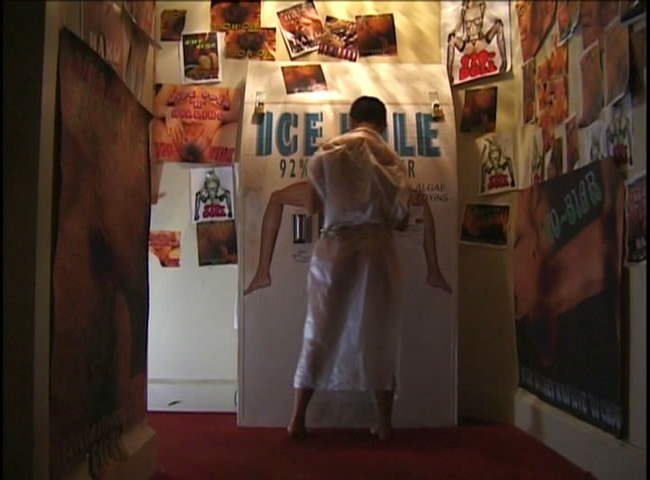
Picture slightly airbrushed out in obvious places. Go here for original.
The Nudity: Fair warning – Ginny Chin-Chin spends well over half the movie either in the buff, in a sheer shower-stall plastic outfit, or in her fishnet get-up. She definitely looks hawt in this, whereas Alik, also nude some of the time, is made to look as nerdy as possible. In addition, we are treated to other random nude chicks we see as the movie progresses. Blood and gore are also in high supply here.
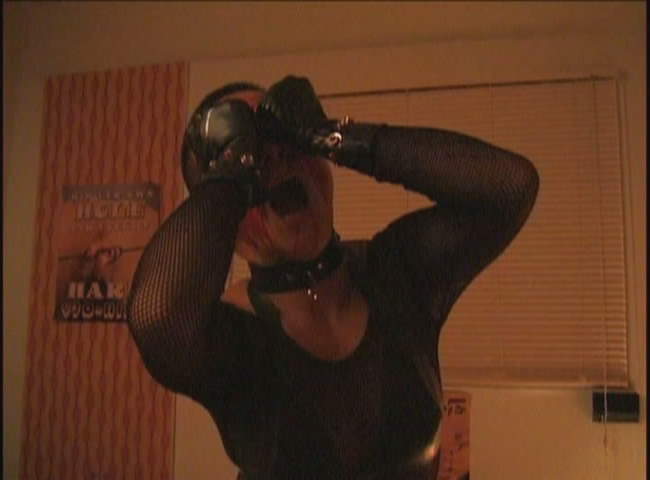
The Props: While at first glance, this movie borders on hard core by having an oral sex scene, if you look closely (or watch the extras), you can see that this is a prop. The dildo prop has various warts on it and spurts blood. Adrian’s facial skin grafts look pretty cool, and generally look like a part of him. Alik’s hacker tools, while extremely low-tech, at least pass some minor degree of believability.
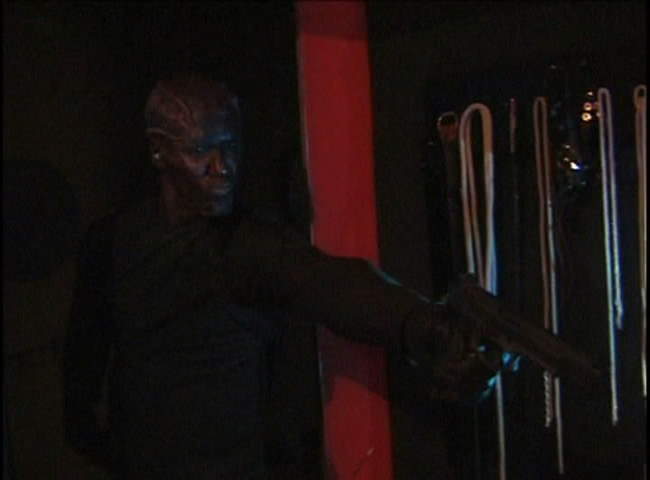
The Sound and Lighting: If there’s a place that Sixteen Tongues falls flat on it’s face, it’s the sound. The actors are clearly not that experienced, and tend to mumble their lines. Worse, McCrae, the director, doesn’t seem to mind. With this combination of poor quality sound reproduction and mumbled lines, the viewer is left to decipher the dialogue in many of the scenes by watching reactions. Adrian and Alik are the worst at this. There are a few scenes of each where the view has no possibility of figuring out what is said. The lighting is also atrocious. Constantly we get over-exposed actors or actors completely blotted out by a bright light behind them.
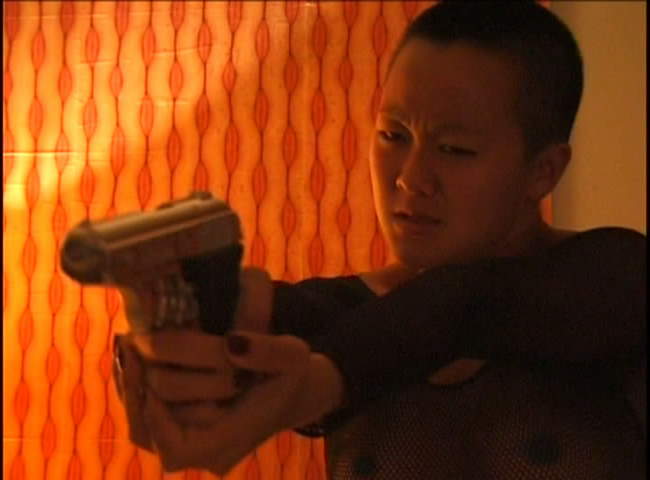
Picture slightly airbrushed out in obvious places. Go here for original
The Bottom Line: Some of the ideas with Sixteen Tongues are pretty interesting. The hacker approach is very similar in some ways to Neuromancer in that it really doesn’t seem to recognize a modern internet, but instead goes towards this almost inaccessible cyberspace that only specialized hackers can use. Unfortunately, some ideas, including the Android assassin bit, and the briefly mentioned bacteria-taking over the body and mind bit are barely even explain. While the plot is problematic and the acting sub-par, it’s the basics – lighting, editing and sound that really doom Sixteen Tongues. Again though, Jane Chase as Ginny Chin-Chin does look pretty smokin in her various get-ups. So if you want to see a bizarre, edgy, low-budget approach to cyberpunk with lots of nudity and gross scenes sprinkled throughout, you might get some enjoyment out of this.
~See movies similar to this one~
Year: 1995
Directed by: Albert Pyun
Written by: Albert Pyun (story and screenplay), Christopher Borkgren (screenplay)
IMDB Reference
Degree of Cyberpunk Visuals: Very Low
Correlation to Cyberpunk Themes: Low
Key Cast Members:
Chance O’Brien: Keith Cooke
Jo: Tina Cote
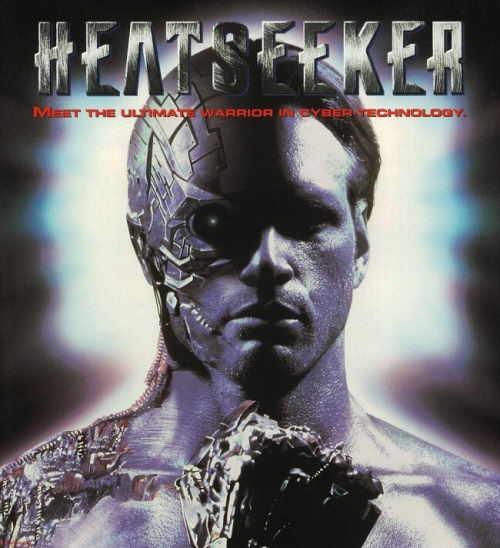
Overview: This has to qualify as one of the most misleading promotional photos ever. This movie has NONE of those cool cyborg stuff in it. Heatseeker is a low budget martial arts tournament fight movie wrapped in a cocoon of cheesy dialogue that calls the fighters cyborgs - but there is pretty much NO visuals to that effect. In this movie which takes place in the near-future, where cyber-corporations, emeshed in a global competition to be the leader in cyber technology have devised a martial arts tournament to see who has the best cyber-equipment. Chance O’Brian (played by Keith Cooke) is the martial arts champion of the world, and is going to marry his trainer, Jo (played by Tina Cote). Some evil, nasty, mean, rotten (did I get the point across) cyber corporation types abduct his wife and force him to fight in a tournament of cyborg fighters to give the fight legitimacy. Also, Jo has to have sex and train the evil, nasty, powerful, mean and rotten cyber-corporation’s champion, who just happens to be Chance’s chief rival. The tournament goes on, but I think you can pretty much guess how this goes.
The Bottom Line: From a story perspective, Heatseeker doesn’t even make an attempt to be anything but a low-priced piece of crap. The acting is downright horrid in places and the characters are the epitome of one dimensional. The only redeeming value in this are the fight sequences, which are usually decent. For this reason, I give it an extra star for the fight sequences, but I take one away for the misleading promotional picture, and another away from the completely non-believable ending sequence.
~See movies similar to this one~
Year: 1998
Directed by: Richard Gabai
Written by: Richard Gabai & L.A. Maddox
IMDB Reference
Degree of Cyberpunk Visuals: Low
Correlation to Cyberpunk Themes: Low

Overview: This is one of the many cheesy soft-core porns where a woman in a VR simulation becomes “real” and falls in love with the VR system creator. This genius game designer creates a CD-Rom sex game called “Virtual Girl,” but somehow, the hot chick in the game becomes sentient and wants to boff his brains out. She does every fantasy he desires, and things are great until the programmer realizes he might be cheating on his wife (duh!). He tries to drop her, but the virtual girl then goes all Fatal Attraction on him, and decides to get back at him. The Virtual chick magically transforms herself into a real person in the real world and sets out to destroy his marriage, ruin his job, etc. Truly, there’s nothing all that great here (such as a coherent plot, decent acting and so forth), but there’s at least decent amount of cheesy Skinemax style love vignettes.
~See movies similar to this one~
Tags: cyberpunk movie review VirtualGirl
Year: 2000
Directed by: Mark Neale
Written by: Mark Neale
IMDB Reference
Degree of Cyberpunk Visuals: Very Low
Correlation to Cyberpunk Themes: Low
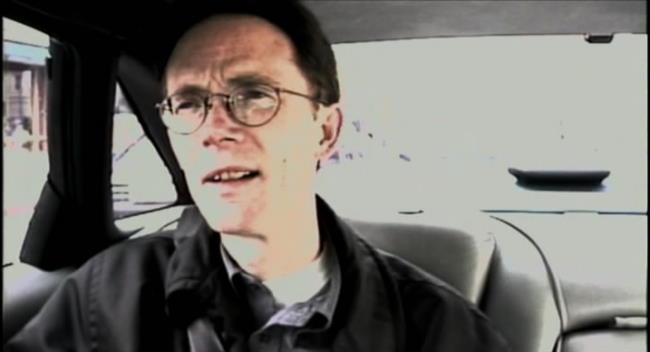
Overview: I notice the decent IMDB rating for No Maps, but honestly, I just don’t see it. I have hard time coming up with something positive to say as No Maps for These Territories as a documentary on Gibson fails in virtually all aspects possible. You have to look long and hard to find a documentary with this little attention to detail across the board. No Maps has horrible lighting, haphazard editing and “FX” choices which detract even more from the mess that’s already on screen. In short, this film seems to be sending the message that William Gibson is a meandering scatterbrain who occasionally comes up with an interesting idea or two, but who, for reasons not of his own making, was able to become wildly popular. None of this is true of course, which is why this documentary resonates so badly with me.
Because I also gave New Rose Hotel a horrible rating, I want to be VERY clear about something – I think William Gibson is one of the most influential writers of the later part of the 20th century. His stuff is better than great. In no way does my knocking these movies reflect at all on my opinion of his literary works or his legacy. Nor do I believe that Gibson’s works cannot be very successfully transferred on-screen. Unfortunately, Gibson has yet to find his Peter Jackson.
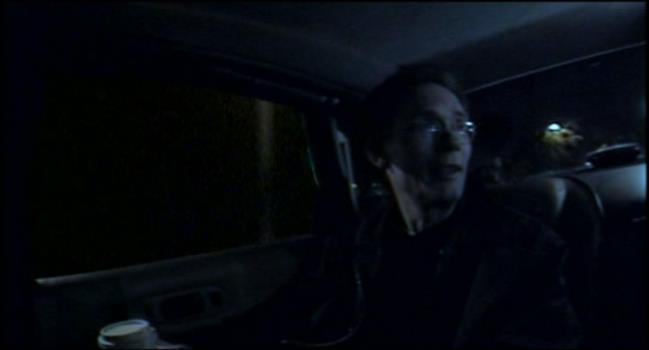
I’m guessing the cup is a prop to get more light into the picture…
The Setting: A significant part of my dislike for No Maps is based on the decision to use a car as the setting. In thinking about it, it’s really hard to imagine a worse way to conduct a documentary. The entire thing takes place with Mark Neale, the director, driving a car while talking to Gibson, who is in the back seat surrounded by a few of set cameras. In using this approach, Neale was able to generate the worst of all scenarios:
- Neale has to focus on driving so he has absolutely NO control over the cameras. This continually leads to horribly over or under-exposed shots of Gibson, grainy, and out of focus film and horrible positioning.
- Because Neale has to concentrate on driving, whatever skills he might have had as an interviewer are compromised by the fact that he’s in massive multitasking mode – he’s driving and continually checking the recording while attempting conducting an interview. My guess is after a while, Neale just wanted to make sure Gibson was talking, and stopped bothering listening to what was being said.
- Every now and then, Gibson would utter a terrific insight, such as when he mentioned that the internet all but ensured the end of the nation state. This would have been a great time for a prompting follow-up from an astute interviewer, but unfortunately, we get absolutely NO follow-up on this and many similar fascinating comments.
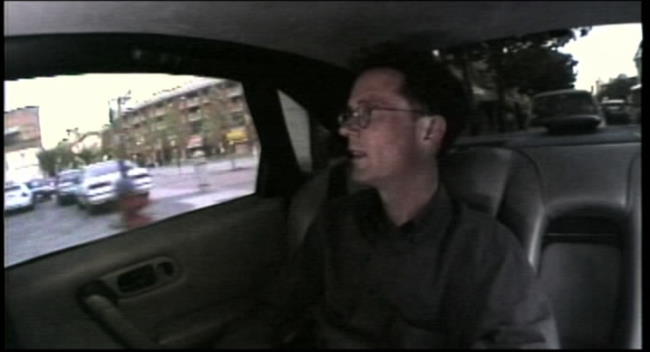
Notice that the left window scene doesn’t match with the rear window - this was intentional.
What the Cinematography Conveyed: Probably the most dissapointing aspect of No Maps relates to the unintentional visual symbols the “road trip” documentary provided. Gibson is known as a trailblazer – a thought leader in setting the course for science fiction, yet the interview in the back of the car makes him seem like someone happy to follow along someone else’s path. The title, “No Maps for These Territories ” is supposed to convey that Gibson went into un-chartered waters, yet everything in this documentary, from the meandering and repetitive music to the monotonous car ride, makes Gibson come across as someone who basically just intellectually wanders around and hopes he happens upon something interesting. In short – there was a map of the territory – it was in Gibson’s mind. This film works hard to obfuscates that fact:
- The constant penchant to splice in absolutely random images in rapid succession whenever Gibson philosophizes tends to make Gibson’s message come off as incoherent.
- The repetitive music consistenty has this meandering quality, which again, reinforces the message that Gibson wanders around through life and occaisionally gets lucky.
- The “special effects” where Neale haphazardly transferred separate drive-by the images onto the side and rear window and back side of the car so that what was coming through rear window no longer matched the side window (see image directly above for an example) served NO PURPOSE AT ALL other than to distract the viewer from Gibson’s oratory.
- The complete inattention to lighting or setting makes the entire project comparable to a neighbor’s home movie. It’s almost as if Neale was consciously trying to make Gibson (and Sterling) look as shabby as possible with the hopes that it made them more “edgy” or “real.” If this was the intent, my apologies for missing how this was helpful.
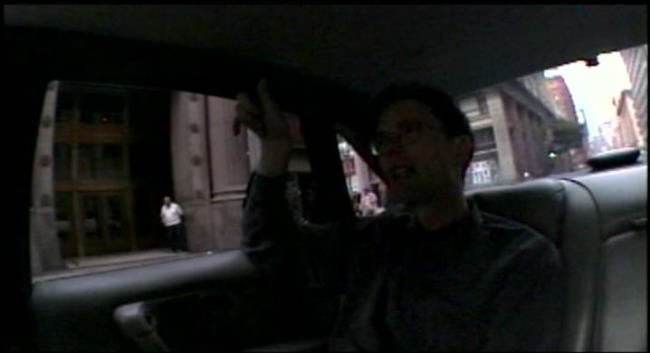
No, I didn’t have to look hard to find quality lighting shots like this one.
Perhaps the goal was either to break up the monotony of staring at Gibson in a back seat of a car for 88 minutes, or maybe it was done with the hope of making Gibson’s oratory seem non-linear, but what seems to be conveyed is that Gibson’s ideas aren’t really connected in any real way. In line with this, Gibson as the “meanderer” is re-enforced by poor editing decisions. While a few segments such as the internet one seem to have a nice flow, most segments are all over the non-existent map. What Neale unintentionally seems to convey is that if you keep a camera on Gibson long enough, like the rest of us, he’ll eventually come up with a a number of half-formed, off-the-cuff comments that go absolutely nowhere.
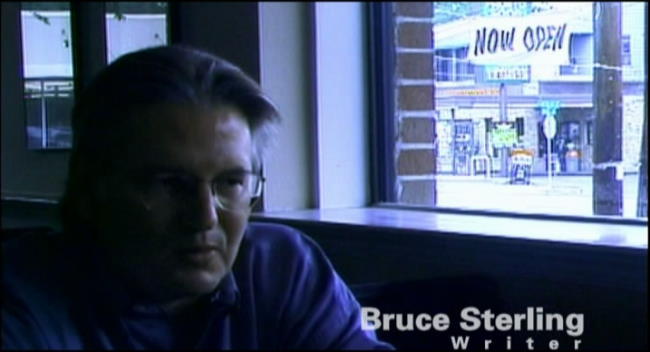
Was this shot intentional? Does Mr. Sterling own a gas station and like Marlboros? If so, probably they should have worked the camera better, as often only half of the gas station is showing.
Neuromancer’s Legacy: One thing we do learn from No Maps is that Gibson, like many great innovators, is probably the worst person to talk about his place in history, and in particular, the relevance of his earlier works like Neuromancer. When it comes to discussing his legacy, Gibson is extremely modest. He’s also a perfectionist when it comes to evaluating his prose. As he gets older, he negatively judges his earlier and discounts their value and overall importance. In discussing Neuromancer, Gibson calls it a simplistic book – as simplistic as cheesy three-chord progression songs in Album Oriented Rock music in fact, and that only teenage Goths should ever find it appealing. Never mind that it won all possible scifi awards (Hugo Award, Philip K. Dick Memorial Award, Nebula Award, Seiun Award, and Ditmar Award) and defined a whole new genre of science fiction, or that it changed the vocabulary and concepts the world over (the concept of cyberspace, for instance), Gibson still considers it pretty sophomoric. This leads to the clear implication that those who see something more in Neuromancer, or any of his 80s works, are also of the intellectual caliber of teenage Goths. Yet, in his five minute interview at a cheesy restaurant (also with shitty lighting), Bruce Sterling is able to provide more context on Neuromancer’s place in history than Gibson does for the rest of the film. Sterling points out clearly that while Gibson as an older man looking back at his life may have the right to criticize himself, but this doesn’t change the fact that he was a damn good writer back then who transformed the face of science fiction – I only wish there was an interviewer in this capable of pinning Gibson down on this. While Gibson may or may not like the prose, the ideas proposed clearly had intrinsic worth, and every so often, even Gibson acknowledges this.

This shot, which we see quite frequently in No Maps, perfectly sums up the documentary.
The Bottom Line: On the whole, this documentary performed a disservice to Gibson and his legacy. Those who have never been exposed to Gibson will watch this and conclude that Gibson was a lucky bystander in history who seemed to be at the right place at the right time. If you’re already a Gibson fan, you may get a bunch of interesting and honest tidbits from his past, but little else will be gained. In watching No Maps, I really found myself wishing that Neale had just gotten a semi-decent interviewer to sit down with Gibson in a quiet setting and interview him. Also, far more time should have been given to Gibson’s contemporaries, who clearly have a better sense of Gibson’s significants than he does. Had Neale taken this approach (one might call this a traditional documentary approach for lack of a better description), the result would have been FAR superior to the mess that this documentary produced. Again, the problem wasn’t that No Maps was produced on a shoestring budget, the problems arose from the choices made (using a moving car as the setting, where the director/interviewer/cameraman/driver was one in the same person, and the subsequent editing decisions). Yes, the name of the documentary is VERY cool, but very little else should be saved. Gibson deserves better. If history is kind, No Maps will be forgotten, and at some point, a quality documentary will be made that highlights Gibson’s most impressive legacy.
~See movies similar to this one~
Tags: cyberpunk movie review Gibson Territory Maps
|


































